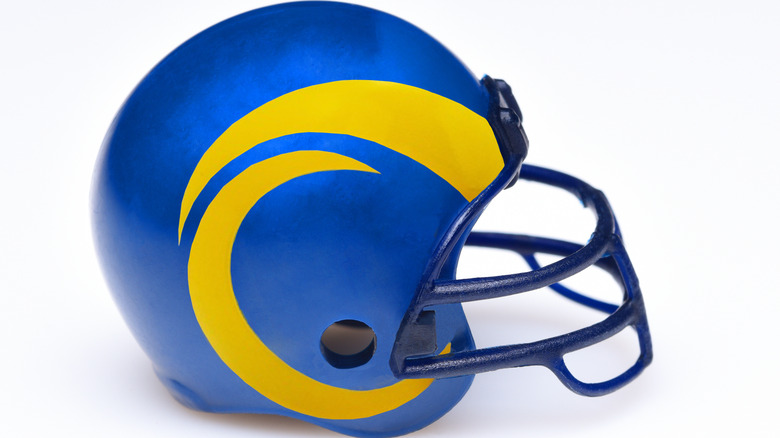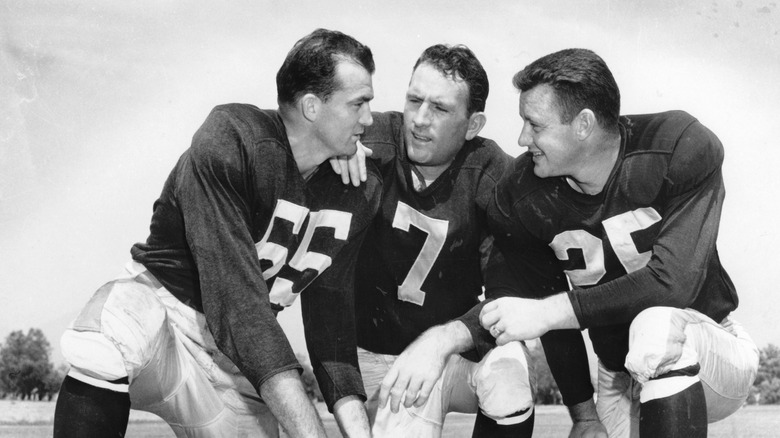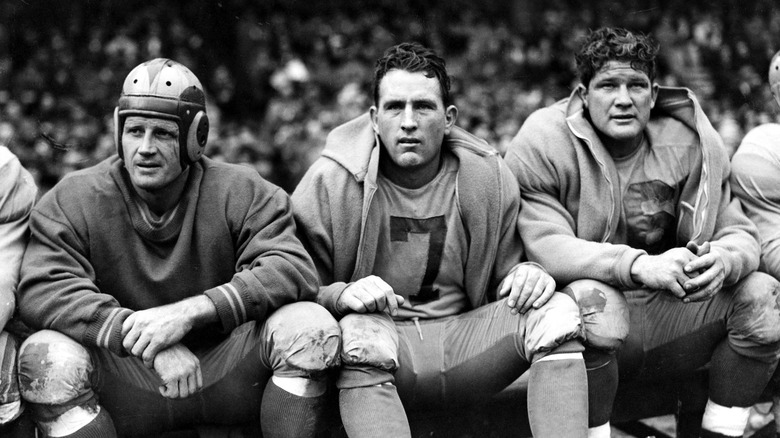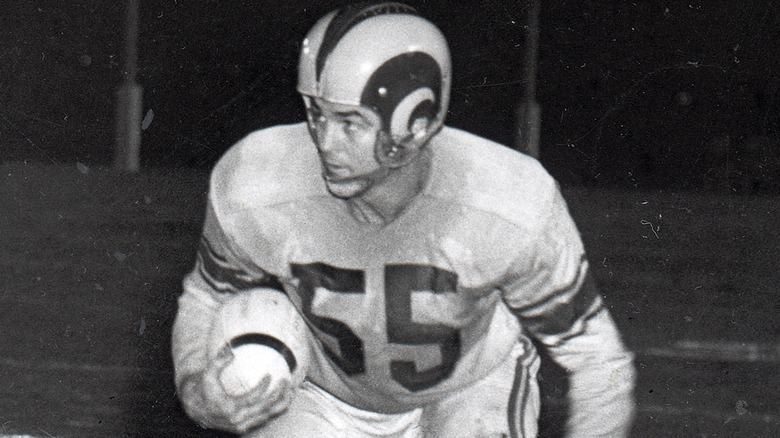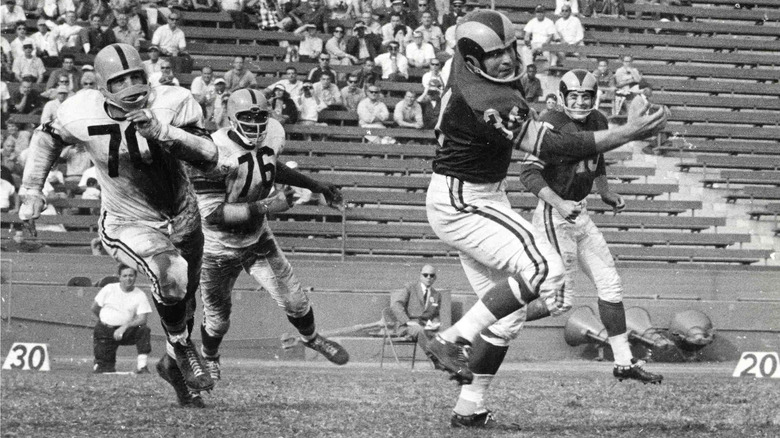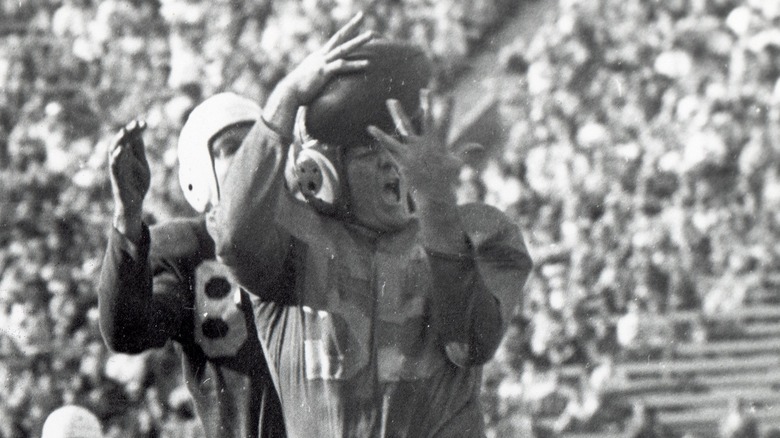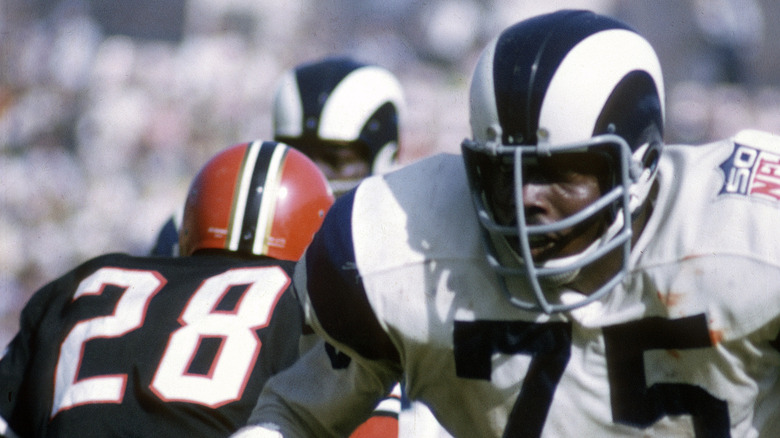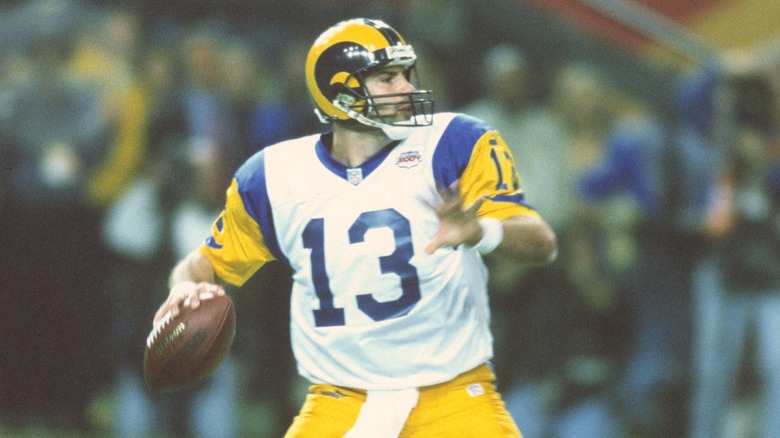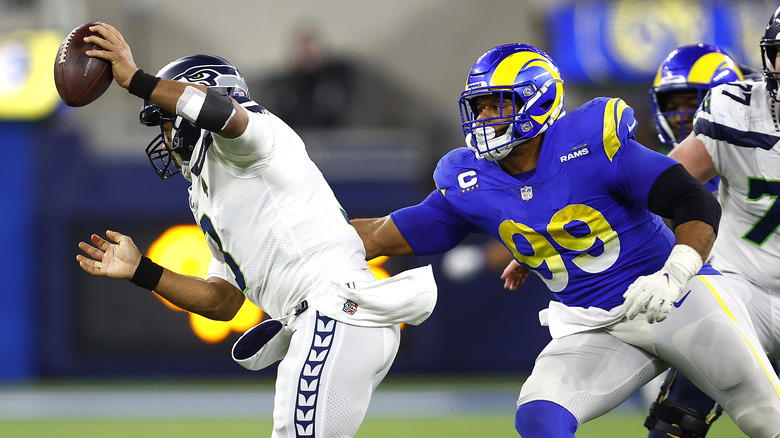The Untold Truth Of The Los Angeles Rams
Even people who are the most casual of football fans would be able to turn on a football game and know whether the Los Angeles Rams are playing. The team's iconic curled horns that have donned players' helmets for most of the franchise's history are one of the most iconic and instantly recognizable symbols in the history of professional sports.
The Rams are a storied franchise that has been through a lot. According to Pro Football Reference, they can claim multiple Super Bowl appearances including one victory, a pair of championships in the days before the Super Bowl, and scores of legendary players who have worn the team's various blue and gold uniforms.
However, the team has also been through some rough times. Stretches of sub-par performances and a handful of relocations, most recently in 2016 when the team — for the second time in their history — set out for the West Coast to the city that has become most synonymous with the team, Los Angeles.
The franchise started as the Cleveland Rams
The start of the Rams franchise goes all the way back to 1937 and starts off in a city that most don't associate with them: Cleveland. Thing's didn't get off to a roaring start as the team's first season saw them sitting at the bottom of the standings posting a 1-10 record, per Pro Football Reference. For the next six seasons, the team would bounce between third, fourth, fifth-place finishes in their five-team division.
Adversity would come the team's way in 1943. With the United States in the midst of World War II, the entire country was faced with worker shortages. Professional football was not exempt from this issue, according to the Pro Football Hall of Fame. and it was the reason the Cleveland Browns went on hiatus during the 1943 season. Only eight teams would take the field that season, and the Rams weren't the only club affected by the manpower shortage. The Pittsburgh Steelers and Philadelphia Eagles were forced to combine into one team that would become colloquially known as the Phil-Pitt Steagles via the Philadelphia Eagles.
The Cleveland Rams return from their hiatus and fine success ... then skip town
The Rams re-emerged from their 1943 hiatus and took the field in the fall of 1944. It was the same old, same old for the Cleveland iteration of the team as they posted a 4-6 record, good for only 4th in their division (via Pro Football Reference). However, years of toiling away during the team's leather helmet era would pay off in 1945.
On the field, the team exploded, posting a 9-1 record, far exceeding anything the team had been able to accomplish at that point in their history. Led by head coach Adam Walsh the team found themselves earning a trip to the NFL championship game. There they met Washington, beating them by a final score of 15-14. According to the Pro Football Hall of Fame the teams' quarterback, Bob Waterfield, was named Player of the Year. Waterfield had played college football at UCLA, a touch of irony considering what was in the cards for the Cleveland Rams moving forward.
The championship was a huge step in the right direction for the team, but it would be their final game representing the city of Cleveland. Back in 1941, the team had been purchased by a businessman named Dan Reeves. According to The New York Times, Reeves had inherited money from his father, an Irish immigrant who founded a chain of grocery stores. It was Reeves who decided the franchise would make the big move to the West Coast ahead of the 1946 season.
The early days in Los Angeles and the birth of the horns
Relocating a team immediately after winning a championship is something that would typically be seen as a head-scratcher, but it would turn out to be a stroke of genius and impressive foresight on the part of Dan Reeves. The New York Times cites the Rams' move from Cleveland to Los Angeles as the catalyst that would see a series of similar moves across the sports landscape. Before the move, major franchises could only be found scattered throughout the Northeast and Midwest. Others would follow suit as Major League Baseball's Brooklyn Dodgers and New York Giants, and the National Basketball Association's Milwaukee Lakers found California homes in the coming years.
The Rams moved into their new home the Los Angeles Memorial Coliseum, and posted a respectable, if not stellar 6-4-1 record in 1946, good enough for second in the NFL's West Division. It was that season according to the Pro Football Hall of Fame that Reeves signed Kenny Washington and Woody Strode, which made them the first two Black players with NFL contracts since 1932.
Another key moment for the franchise in 1946, concerned their helmets. Player Fred Gehrke painted a set of horns inspired by the team's logo on his helmet, reports Sports Illustrated. It got the thumbs up from Reeves and the idea was adopted by the team, and his been present on their helmets ever since.
Innovation under Reeves and rivalry with the Dons
Throwing part of the team's logo on their helmets wasn't the only innovation made by the Rams under Dan Reeves. According to the Pro Football Hall of Fame, Reeves started a program called "Free Football for Kids" which was designed to instill a love of the game in kids in hopes that they would become lifelong football fans. Reeves was also integral in developing the early versions of the TV policies used by the NFL, and he would introduce another first for the NFL in the form of a full-time scouting staff.
Upon moving to Los Angeles, the Rams did find themself with some competition when it came to attracting fans. The Los Angeles Dons played in All-American Football Conference, an upstart that included future NFL franchises the Buffalo Bills and San Francisco 49ers. Fortunately, the Dons folded with the All-American Football Conference in 1949. This was great news for the Rams as they were left as the only big-ticket football team in town, and were about to embark on a period of immense success.
Late-'40s, early-'50s successes
1949 was the first of three successive first-place division finishes for the Rams and three straight championship game appearances. The Philadelphia Eagles were the Rams' opponent in 1949, and they probably wish they hadn't been. The Eagles triumphed, 14-0, putting up nearly triple the offensive yards accumulated by the Rams; 342 to the Rams' 119.
The Rams would meet the same feat in 1950, only instead of being shut out, the team would face a 30-28 gut-punch loss to their Cleveland successors, the Cleveland Browns. The third time was the charm and in 1951, the Rams would take their first championship in their West-Coast existence, getting revenge on the Browns in the process with a 24-17 win.
The Rams would make a final 1950s championship appearance in 1955, which resulted in a loss, but the period of success helped the team grow in popularity. A 1957 game against the San Francisco 49ers drew 102,368 fans, according to the Pro Football Hall of Fame.
The Rams unleash The Fearsome Foursome
The Rams would have a relatively quiet 1960s but would become contenders again in the 1970s. Sadly, the team's strong decade would start off with the death of Dan Reeves in 1971, per The New York Times. The team would eventually fall under the ownership of Carroll Rosenbloom, which he acquired by swapping his Baltimore Colts with Robert Irsay who had acquired the team after immediately Reeve's death. On the field, the Rams would unveil one of their most iconic lineups, the legendary Fearsome Foursome defensive line consisting of Lamar Lundy, Roger Brown, and Hall of Famers Deacon Jones and Merlin Olsen, per the NFL.
Through the '70s, the Rams would be perennial post-season fixtures, but they were never able to clinch a Super Bowl victory, their only appearance coming in Super Bowl XIV, a 31-19 loss to the Pittsburgh Steelers.
Once again, tragedy struck Ram's ownership before the decade came to an end. Rosenbloom drowned while swimming in Miami in 1979, according to The New York Times.
The Rams take St. Louis and finally clinch a Super Bowl
According to the Pro Football Hall of Fame, following Rosenbloom's death his widow, Georgia, assumed control of the team. She would lead the team through the 1980s and 1990s. While the team made most appearances in most seasons throughout the 1980s, per Pro Football Reference,
The 1990s would be followed by a rough patch for the franchise that would see no postseason appearances — and no winning seasons — from 1990 through 1998. In 1995, the Rams packed things up in Los Angeles and for the second time in their history, the team relocated. This time they would head east to St. Louis. The losing ways the team had developed toward the end of their first Los Angeles stint continued for the first few years in St. Louis, but fortunes changed at the tail-end of the decade.
The 1999 season saw the Rams post a phenomenal 13-3 record, easily good enough for first in their division. After wins over the Vikings and Buccaneers, they were en route to Super Bowl XXXIV matchup with the Tennessee Titans. They would wind up winning the first and — to date — only Super Bowl victory in franchise history, by a score of 23-16 with Rams quarterback Kurt Warner receiving MVP honors.
Decline and return to Los Angeles
Following their Super Bowl victory, the Rams only had to wait two seasons to take a crack at a second ring. However, they wound up meeting Tom Brady and the New England Patriots in Super Bowl XXXVI. After that, the team would only see two more post-season appearances during their time in St. Louis which culminated in a dry spell from 2005 to 2015.
According to ESPN, in the midst of the team's lean years, they were acquired by real estate developer Stan Kroenke in 2010. In addition to the Rams Kroenke also owns the NHL's Colorado Avalanche, NBA's Denver Nuggets, the MLS's Colorado Rapids, and the English Premier League's Arsenal F.C. (via Forbes).
The Rams' departure from Los Angeles in the mid-'90s left a football void in one of the country's biggest markets. Kroenke changed that by moving the team back to Los Angeles in 2016. The second stint in L.A. started out slow with only a 4-12 record in their first season back. However, after that, they would see a period of sustained success especially under head coach Sean McVay, with the team making it to Super Bowl LIII — a loss to Tom Brady and the Patriots once again — and Super Bowl LVI against the Cincinnati Bengals.
